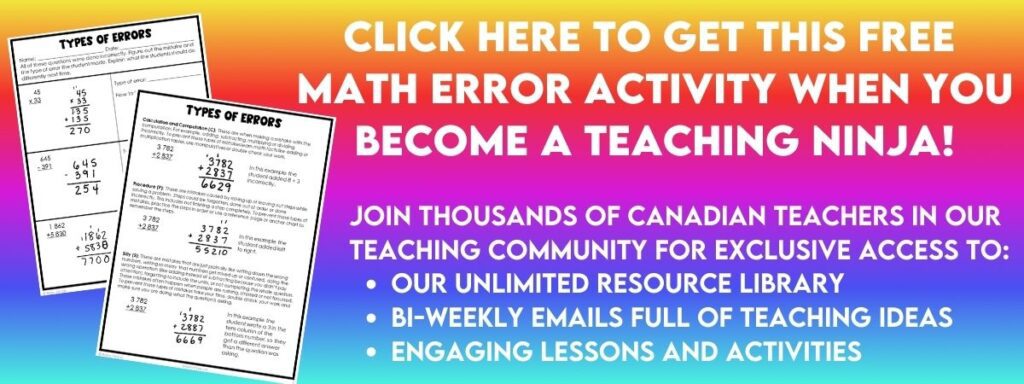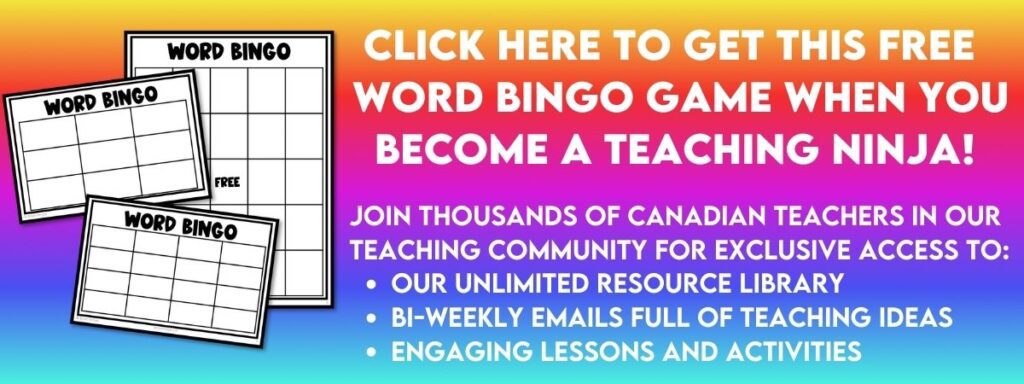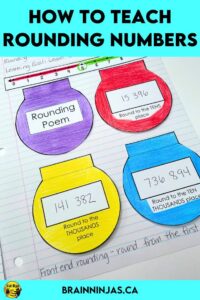
Rounding numbers is an important mathematical skill for everyday life. Understanding how to round whole numbers and decimals not only strengthens numeracy skills but empowers students to make informed estimations and calculations. Gone are the days of teachers being able to use the “you won’t have a calculator with your every way you go” as the excuse for learning to round numbers. Instead, students need to understand all the different uses for rounding and how it relates to estimating. Learn how we teach rounding numbers in our upper elementary classroom.
Introduce Rounding Numbers
Explain the concept of rounding. Round numbers usually end with a zero Is it because the numbers end with zero and zeroes are round? Or is it because the numbers are around? The numbers are imprecise or are an estimate. Words like about, approximate or probably are often used in conjunction with the amounts. For example, there are about twenty students in a classroom (wouldn’t that be nice?). Rounding is used because it is quicker than doing calculations of exact numbers.
We use rounding all the time. When we’re shopping, we estimate prices, amounts like weight, or costs or when we choose the number of items needed for a recipe. In the news, numbers are often rounded to talk about populations. A town might have 50 000 villagers. There are about 70 000 species of trees in the world. When speaking about large numbers, rounded numbers are easier to communicate.
Teach the Basic Rules
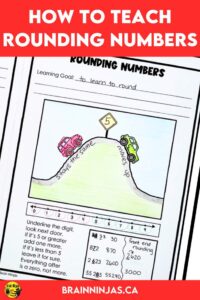
Make it Visual
Before we teach anything with numbers, we do a simple demonstration to help students visualize. Draw a hill shape on your whiteboard. Pretend your whiteboard marker is a car. It helps if you make vroom sounds. “Drive” the whiteboard marker up the hill, but pretend the car can’t quite make it and roll back down. “Drive” the marker up and over the hill so it makes it to the other side.
Explain that for a car to make it up over a hill, it has to have enough momentum. Rounding works like this, too. If a number is 0, 1, 2, 3, or 4 there is not enough momentum. Have your students give you a number from zero to four. Demonstrate that the “whiteboard marker car” can’t make it over the hill. If a number is a 5, 6, 7, 8, or 9, then the car will have enough momentum. Have students give you a number from five to nine and demonstrate how the car makes it.
Have students give any one-digit number to practice making it or not. Students can also take turns driving the car. This visualization will help students as they learn to round numbers.
Show a Real-Life Use
In Canada, we don’t have pennies. This means when a customer pays with cash, they must round to the nearest five cents. Change is also given this way. So, if it costs $9.97, the customer pays $10.00.
Front-End Rounding
We start with front-end rounding. This means rounding the number to the first digit. Front-end rounding is helpful when needed to do quick calculations or make estimates.
Take the first digit and look at the digit to the right. If this digit is 4 or less (0, 1, 2, 3, 4) then the first digit stays the same. If the digit to the right is 5 or more (5, 6, 7, 8, 9) then the first digit goes up by one. When front-end rounding happens, the first digit is a number and everything else becomes a zero.
Rounding to a Target Place Value
Students need to know the place value names to round to specific place values. Review these before teaching rounding. Target place value rounding means rounding the number to the specific place value and all the rest of the numbers become zeros. It is often used for describing amounts (like populations).
Take the digit in the specific place value and underline it. Look at the digit to the right. If this digit is 4 or less (0, 1, 2, 3, 4) then the underlined digit stays the same. If the digit to the right is 5 or more (5, 6, 7, 8, 9) then the underlined digit goes up by one.
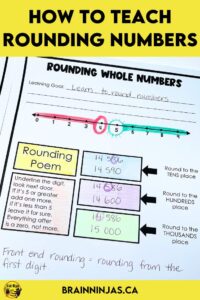
Have your students learned about decimals yet? You can continue the targeted place value rounding into tenths, hundredths and thousandths.
Explicitly Teach Rounding
We include rounding in our lessons partly because it is an outcome for some grades and partly because understanding rounding helps with estimation. Our lessons are part of our Interactive Math Units. These units include lesson plans, background information for the teacher, student practice pages, activities and assessments, so you’ll have everything you need to teach, review and assess without all the planning.
- The Numbers and Fractions Interactive Math Unit for Grade 3 is available on TpT ($USD) or our BN Shop ($CAN).
- Number Concepts Interactive Math Unit for Grade 4 is available on TpT ($USD) or our BN Shop ($CAN).
- Find the Number Concepts Interactive Math Unit for Grade 4/5 (designed for combined grade level classes) is available on TpT ($USD) or our BN Shop ($CAN).
- Number Concepts Interactive Math Unit for Grade 5 is available on TpT ($USD) or our BN Shop ($CAN).
- Find the Numbers and Integers Interactive Math Unit for Grade 5/6 (designed for combined grade level classes) is available on TpT ($USD) or our BN Shop ($CAN).
- Numbers and Integers Interactive Math Unit for Grade 6 is available on TpT ($USD) or our BN Shop ($CAN).
Use Videos
Videos are an effective way to see rounding in action. These are a few of our favourites.
Khan Academy has a whole bunch of videos divided into more specific outcomes such as specific place values. You can find all the rounding videos here.
Math Antics (on YouTube)
Numberock has lots of songs for different concepts on YouTube. They are catchy and a good introduction. Watch the Numberock video here.
Practice and Review Rounding
Worksheets
We have worksheets to use for practice, review or even assessment. Our worksheet sets are just practice pages and do not include lessons. We have an entire post with ideas on how to turn the worksheets into games: Math Worksheet Games Your Students Will Love.
- Rounding Numbers to 1 000 is available on TpT ($USD) or our BN Shop ($CAN).
- Find Rounding Numbers to 10 000 on TpT ($USD) or our BN Shop ($CAN).
- Rounding Numbers to 100 000 is available on TpT ($USD) or our BN Shop ($CAN).
- Find Rounding Numbers to 1 000 000 on TpT ($USD) or our BN Shop ($CAN).
- Rounding Numbers to 10 000 000 is available on TpT ($USD) or our BN Shop ($CAN).
- Find Rounding Numbers to 1 000 000 000 on TpT ($USD) or our BN Shop ($CAN).
If you need a resource to practice rounding decimals, we have that, too.
- Find Rounding Decimals to Thousandths on TpT ($USD) or our BN Shop ($CAN)
Rounding Game
Organize a relay race where students are given numbers to round to the place value of your choice or to use front-end rounding. Each team member must correctly round their number before passing the baton to the next teammate. This activity encourages teamwork and quick mental calculations.
Task Cards
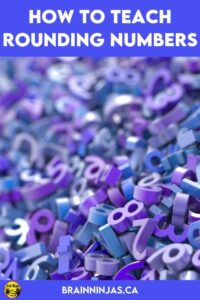
Our task cards do not come with lessons, but each set does include three different decks so they make differentiation easy. Each set can be played using one of the three options. If you use paper (which you have to print and cut apart), students write their answers on the recording sheet or they can call them out orally. If you use the Google Slides versions, you can project the questions or assign them in your Google Classroom. Students can write on the paper recording page, write their answers on the slides or call them out orally. There’s also a Google Forms version that you can use as an assessment. Instructions for setting that up are included in each set. You can also download the Google Slides version as a Microsoft PowerPoint if you need it in that format.
Rounding Numbers Task Cards (we’ll include the number range and not the grade level) on TpT ($USD) or our BN Shop ($CAN).
Error Analysis
Make intentional errors and have students be the teacher. This can be done using any of the worksheets or task cards. We teach students about errors in this simple activity. The error analysis activity uses operations, but you can easily change out the questions for rounding. If you’re already a ninja, the activity is available in the Resource Library. If you’re not a ninja, we’ll send it directly to your inbox when you join our email list.
Round the Room
Create a rounded number. Write five to ten numbers that when rounded, will become this number. Repeat this for as many students as you have or numbers to practice. Post the rounded number on the whiteboard or at the front of the classroom. Place the rest of the numbers on cards around the classroom. Ask students to round the numbers by physically moving to the correct card.
This works great for front-end rounding, but you need more rounded numbers. If the numbers need to be rounded to specific place values, be clear with students before you start to avoid confusion. It works best if everyone is rounding to the same place value.
Number Lines
Provide students with a large number line on the floor or wall. Give them various numbers to round, and have them place a marker on the number line to demonstrate the rounded value.
Rounding Bingo
Create bingo cards with numbers to be rounded. Call out numbers, and students have to round them correctly on their bingo cards. This game enhances familiarity with the rounding process.
We have a set of bingo cards that you can edit. We use them with words, but they work for this, too. If you’re already a ninja, find the cards in the Resource Library. If you’re not a ninja, we’ll send them directly to your inbox when you join our email list.
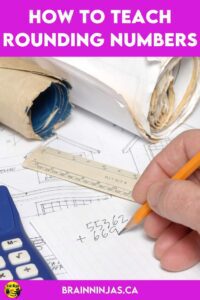
Daily Warm-ups
Include rounding questions in daily warm-up activities. Start the class with a quick rounding exercise to reinforce the concept regularly. This can be as simple as using one of our task card sets each morning to start your day.
Flashcards
Create sets of flashcards. Students can quiz each other in pairs, helping them practice rounding numbers quickly and accurately. Better yet, students can create the cards themselves.
Do You Teach Math?
We have other math posts that you might find helpful.
- How to Unfold Geometry: Books to Shape Your Unit
- How to Help Your Students Master Decimal Operations
- 7 Ways to Upgrade Your Fraction Strategies
- How to Demystify Math With These 7 Algebra Activities
- Conquer Math With These Proven Multiplication Strategies
- How to Make Teaching Patterns Painless
- Amazing Measurement Activities to Stretch Math
- How to Teach Students to Tell Time
- How to Teach Successful Long Division Strategies
- Ways to Bring Graphing Activities into Your Classroom Daily
- Mastering the Angles: Innovative Approaches to Teaching Geometry Concepts
What Else?
Rounding is one of those concepts that students either get right away or struggle with for a long time. Our advice is to continue to use rounding throughout the year in situations where it works naturally. For example, in social studies round numbers for populations. If you have some advice for teaching rounding, we’d love to hear it. Leave us a comment below.

